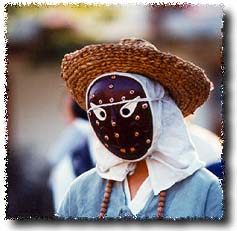

|
Yangju
Byolsandae-nori and Songpa Sandae-nori are
the only mask dance-drama genres with clear roots in the central
Korean region.
Yangju Byolsandae-nori is thought to have grown out of a nearlier mask dance-drama
sometime in the early 19th century.
Located on the banks of the Han River, Yangju was an important transportation
center for the north central region. Mask dance-drama performer
were often subsidized by wealthy landowners or merchants.
Yangju Byolsandae-nori was usually performed on major holidays, such as the
Buddha'a Birthday in spring, at the Tano Festival in the fifth lunar
month,
and on Ch'usok, the Harvest Moon Festival. It was also
performed when Chinese envoys visited Korea and on
the occasion of rain-making rites.
Like Songpa Sandae-nori, the story is important in Yangju Byolsandae-nori.
The main dialogue is between the lecherous Ch'wibari, Malttugi,
a servant, and a villainous nobleman. Comic relief is added
by the Old Monk who acts in pantomime. Dance is also central to
the performance.
As with folk literature from the latter part of the Choson
Dynasty, the debauched monk, the corrupt nobleman, mysterious shamans
and itinerant minstrels make frequent appearances, poking fun at
social contradictions.
Yangju Byolsandae-nori performers were amateurs--usually farmers. A total of
22 different masks, carved from pine, were used in their performances.
|